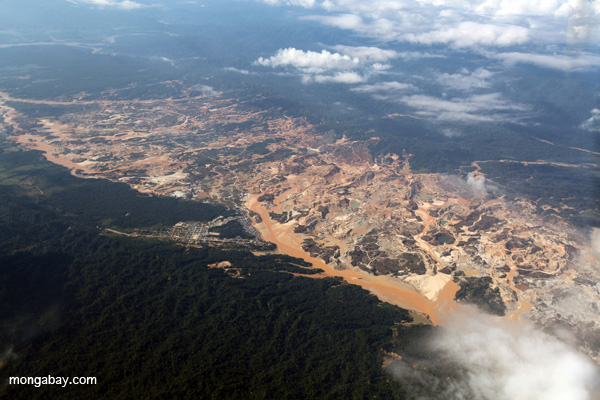- The military presence in Madre de Dios is nothing new: officials have participated in reconnaissance flights and seizure operations for many months.
- The new air force base is expected to be operational in no more than 90 days.
- In 2014, Peru saw greater collaboration and coordination between state agencies fighting illegal logging and mining in Madre de Dios.
Madre de Dios is the heart of Peru’s Amazon; its cloud and tropical rainforests contain a great diversity of animals including birds, amphibians, and threatened species, aside from being home to Manu National Park, a 1,532,806-hectare protected forest, and the Tambopata National Protected Area.
But Madre de Dios is also the country’s epicenter of illegal gold mining. It is believed that around 30,000 artisanal or informal miners make a living there. Their activities have generated a range of irreversible environmental problems in the region: indiscriminate logging, soil degradation, mercury contamination, and the destruction of protected areas and buffer zones.
This past November, the Monitoring of the Andean Amazon Project (MAAP) revealed an analysis of the deforestation in Tambopata National Reserve. Through satellite imagery, the group found that 2,518 hectares (approximately 3,450 soccer fields) have been illegally felled between 2013 and 2015, most of them due to illegal mining activity.
The economic and political power of Madre de Dios’ mining and logging mafias is such, that on the same month that MAAP’s satellite maps were published, hundreds of illegal miners concentrated on the streets of the capital, Puerto Maldonado, and shut it down. At the helm of the indefinite strike was the regional governor of Madre de Dios, Luis Otsuka, a former leader of the regional artisanal miners’ association. They protested the proposal of Law 013-2015–meant to control chemical compounds typically used in illegal mining–as well as Law 1220, a measure seeking to curb illegal logging.
Since then, the government established a dialogue with local communities in an effort to address sustainable development in the Amazonian region. The group, led by José Ávila Herrera of the National Office for Dialogue and Sustainability, alongside the federal government, is focusing on economic development and local investment in health and education.
Their first agreement was announced this week: the need for an air force base, to be located next to the local airport of La Pampa. In other words, the Peruvian military will be in charge of controlling the illegal activity full time, and by the use of force.
Pedro Cateriano, a cabinet member in charge of the dialogue, said this week that the decision showed the commitment of Peru’s federal government. “This shows the president’s political will, and Madre de Dios as an important priority of the political agenda,” said Cateriano, adding that “surely, the debates over this will not be easy.” The decision means the air force base will become operational in a period no longer than 90 days.
The police and military presence in Madre de Dios are nothing new: the air force has participated in reconnaissance flights and interdiction operations there for many months. More recently, in mid-December, an operation in the areas known as Mega 15 and Mega 16 in La Pampa destroyed 86 illegal encampments, and also 25 motors, 30 hoppers, 37 boats, 255 gallons of fuel, and other materials and equipment used by illegal miners in the region.
The year 2014 marked the beginning of greater collaboration and coordination between Peruvian state agencies fighting against illegal logging and mining in Madre de Dios. Peru’s state forestry agency (Organismo de Supervisión de los Recursos Forestales y de Fauna Silvestre, or OSINFOR), its customs agency (Superintendencia Nacional de Aduanas y de Administración Tributaria, or SUNAT), and the Service of National Protected Areas (Servicio Nacional de Áreas Naturales Protegidas por el Estado, or Sernanp) have carried out successful seizures together over the past two years.
Around 100 military personnel are expected at the new air force base soon. They will focus on carrying out more large-scale seizures and providing security in the area.
The initiative already has its critics. Lenin Valencia, a researcher with the nonprofit Peruvian Society of Environmental Rights (Sociedad Peruana de Derecho Ambiental) agrees that the state needs to have a greater presence in Madre de Dios. But Valencia warns that the air force “must follow a protocol for their interventions, because if they don’t, we could end up with new cases of corruption. They’ll need to focus on intelligence; on identifying and interrupting the illegal gold extraction networks in La Pampa.”

